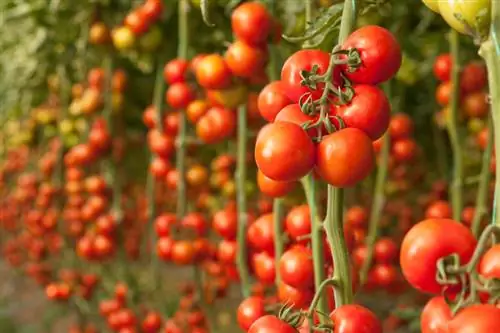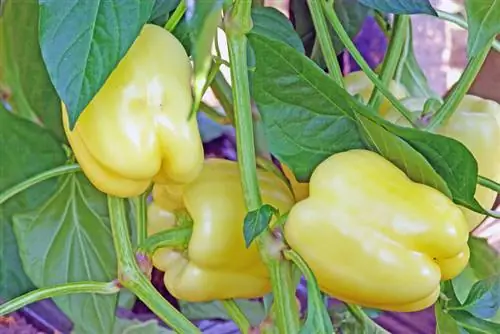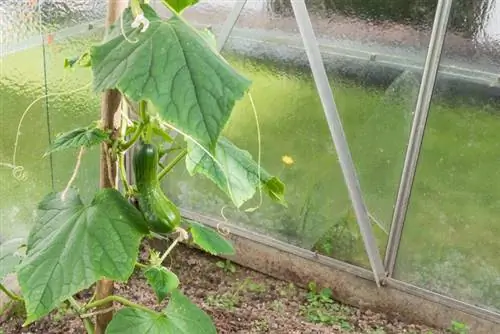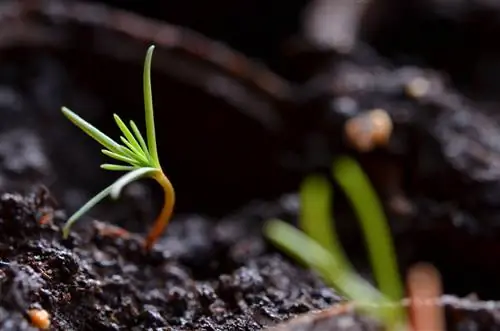- Author admin [email protected].
- Public 2023-12-16 16:46.
- Last modified 2025-01-23 11:19.
Happy hobby gardeners with their own greenhouse for growing tomatoes. Bad weather doesn't put a damper on their plans here. However, proper tomato care is important. Find out all the relevant aspects here.
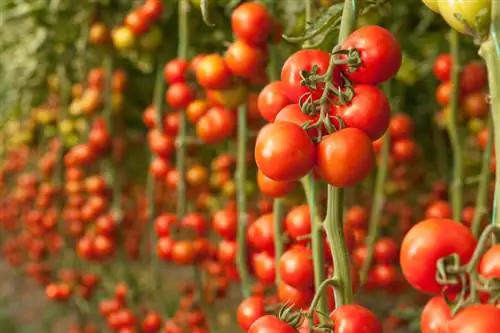
How to properly care for tomatoes in the greenhouse?
Tomatoes in the greenhouse thrive through nutrient-rich, loose soil, optimized planting, targeted irrigation, balanced nutrient supply and consistent pinching. Additional care through underplanting can deter pests and nematodes.
Good care is based on careful preparation
While the cultivation of tomato plants in the house is in full swing in March/April, knowledgeable hobby gardeners are preparing the soil in the greenhouse. When the young plants move into the protected environment of the greenhouse in May, they should find nutrient-rich, loose soil. By the way, it doesn't bother the tomatoes if conspecifics have already been cultivated there - quite the opposite.
- loose up the soil thoroughly and weed thoroughly
- incorporate half-rotted compost at a dosage of 3 liters per square meter
- additionally enrich the soil with horn shavings, rock or algae flour and potash magnesia
- Shortly before planting, sprinkle the bed with horsetail broth to prevent fungal infections
Since meticulous cleanliness is very important in tomato care, all work tools and climbing aids are disinfected.
Proper planting simplifies tomato care
When tomato plants leave their nursery, they should be at least 20 to 25 centimeters tall and have 2-3 flowers. Plant each plant about 6 centimeters deeper than in the growing pot. Adding a little nettle herb to the planting hole improves the starting conditions. A distance of 60 centimeters is considered ideal to easily reach every plant while caring for tomatoes.
Just don’t rain it
Watering tomatoes is a little tricky, given the looming threat of plant diseases. Since wet leaves immediately give rise to fungal spores, watering from above is considered a deadly sin in tomato care. Smart home gardeners have developed much more efficient methods for watering their tomatoes in the greenhouse. This is how it works:
- basically water with tempered rainwater
- alternatively use stale tap water
- always water directly to the roots
- never let the soil dry out or completely soak it
- sudden excess water causes tomato peels to burst
To prevent splashing water from the ground from reaching the leaves, resourceful hobby gardeners dig a flower pot next to the plant. This is filled with water and supplies the soil with the required moisture. In addition, it is recommended to remove the leaves up to a height of 40 centimeters once the plant has reached a suitable height. The result is improved air circulation and reduced risk of splashing water.
Balanced nutrient supply - how to avoid over-fertilization
Although tomato plants are classified as heavy feeders, this does not necessarily mean a constant application of fertilizer at a high level. So that they don't get out of hand, the focus is on a reduced nitrogen supply in favor of potassium, calcium, phosphorus, magnesium and lime. Organic fertilizer should be preferred in this regard.
- fertilize very sparingly with compost until flowering begins
- Incorporate compost every 2 weeks at the same time as the flowers begin, around July
- additionally fertilize with nettle manure, comfrey manure, guano, horn shavings and rock dust
Since mulching plays an important role in tomato care, it should also be used in the greenhouse. A thick layer of comfrey leaves, straw and dried tomato shoots is recommended. If the tomatoes still let their leaves droop or turn pale yellow, you shouldn't be afraid to use a commercially available tomato liquid fertilizer (€9.00 on Amazon).
Maximizing tomatoes in the greenhouse - this is how it works
An indispensable part of tomato care in the greenhouse is consistent pruning. In order to make optimal use of the limited space, it makes sense to use stick tomatoes for the greenhouse. Supported by cords or trellises, the plants climb upwards. Meanwhile, they constantly strive to branch out more broadly. Side shoots develop, which cost the plant a lot of energy.
So that the tomato plant invests its energy in large, juicy fruits, the stingy shoots have to give way. This measure begins in the first week after moving into the greenhouse and continues until after the harvest. Here's how to do it:
- It is advisable to wear disposable gloves
- grab the unwanted shoot in the leaf axil with your fingers and snap it off
- From a height of 15 centimeters, break out to the side with your hand
No confusion possible
Even inexperienced hobby gardeners are not embarrassed by accidentally removing a fruiting shoot instead of a stingy shoot. The visual appearance has the following distinctive identifying features:
- A stingy shoot basically grows precisely in the leaf axil, where the petiole branches off from the trunk
- a fruit shoot comes directly from the trunk, pointing straight ahead
Tips & Tricks
Since tomato plants up to 40 cm high are defoliated to prevent late blight, the soil in the greenhouse looks quite barren. An underplanting of marigolds and marigolds not only ensures a pretty appearance, but also has a repellent effect on pests and nematodes.

